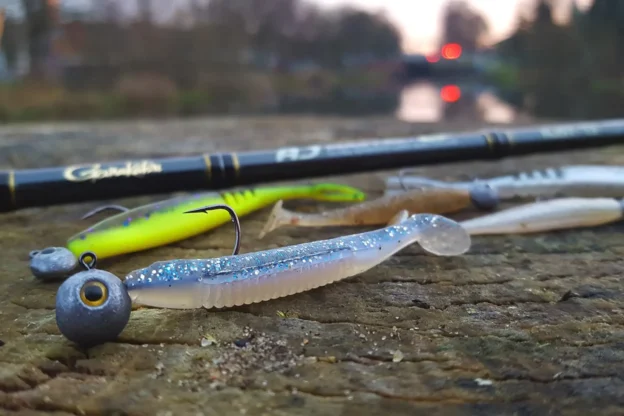Žvejyba jigu jau tapo įprasta daugeliui spiningautojų kuris gaudo plėšrūną. Nors prieš porą dešimtmečių apie tokią žūklę beveik nieko nebuvo žinoma. Ši kryptis buvo sukurta dėl tokios medžiagos, kaip silikonas, naudojimo žvejybos masalo gamyboje. Jigo įranga komplektuojama su silikonine žuvele kartu su įvairaus svorio svoriu, leidžiančiu pravesti masalą skirtinguose vandens sluoksniuose. Guminės žuvelės imitacijos išvaizda ir žaismas yra toks tikroviškas, kad visos be išimties mūsų telkinių plėšriosios žuvys sėkmingai pagaunamos ant tokio gudraus montavimo.
Papildomo populiarumo šiai spiningo žvejybai suteikia paprasta pravedimo technika. Galima teigti, kad žvejyba jigu pradedantiesiems gana lengvai įvaldoma jau per pirmą žūklę, vėliau su kiekviena žvejyba tobulėja. Apie tai, kaip taisyklingai pradėti žvejybą jigu, sukomplektuoti žūklei efektyvius įrankius ir pasirinkti tam tikroms žūklės sąlygoms reikalingą masalą, bus aptarta šiame straipsnyje.
Žvejyba jigu – kas tai
Spiningo žūklės tipas gavo savo egzotišką, bet labai teisingą pavadinimą – masalo judesį sutapatinus su senuoju britų džigo šokiu. Plėšrūno žvejyba jigu pasižymi staigiu ir trūkčiojančiu judesiu, daugeliu atvejų darant pravedimą masalas paliečią dugną. Masalo pravedimo metodai yra dinamiški ir reikalauja nuolatinio stebėjimo. Masalo kontrolė užtikrinama naudojant spiningo meškeres, turinčias gana tvirtas struktūros charakteristikas.
Kaip pasirinkti spiningą jigui
Žvejyba jigu pagrįsta visiška masalo darbo kontrole. Tai pasiekti galima tik naudojant tinkamai parinktą meškerę pagal konstrukcines ypatybes. Spiningavimui naudojama beinercinė ritė su pintu valu. Spiningas pasirenkamas iš lengvų medžiagų – anglies pluošto, grafito ir kompozitų.
Spiningo ilgis
Spiningo ilgio pasirinkimą lemia žvejybos kriterijai. Žvejyba džigu nuo kranto reiškia didelius užmėtimo atstumus, todėl tolimiems metimams tinkamiausi yra 2,5–3,3 metro ilgio spiningai.
Žvejyba jigu iš valties vyksta naudojant trumpesnius spiningus, nes masalų svoris ir užmetimo atstumas nebėra toks aktualus, kaip žvejojant nuo kranto. Spiningo ilgis gali svyruoti nuo 1,5 iki 2,5 metro. Žvejybai jigu iš valties tai yra tinkamiausi ir praktiškiausi variantai.
Spiningo testas
Spiningo testas tiesiogiai priklauso nuo naudojamų masalų. Paprastai žvejybai jigu naudojami Ultra Light, Light ir Medium spiningai. Priklausomai nuo to ką ir kur ruošiatės gaudyti. Ultra Light spiningai naudojami ešerių žvejyboje jigu. Light ir Medium spiningai dažniausiai naudojami lydekų, starkių žvejyboje. Šiuo metu didelį populiarumą įgauną lydekų žvejyba dideliais masalais kur naudojami Heavy spiningai. Daugiau apie spiningo pasirinkimą lydekų žvejybai galite paskaityti šiame mano straipsnyje.
Ritės pasirinkimas
Žvejybai jigu dažniausiai naudojamos beinercinės ritės. Šiuo metu rinkoje yra itin didelis ričių pasirinkimas. Ritės dydis svyruoja nuo 2000 iki 4000 dydžio. Detalesnę informaciją apie ritė pasirinkimą rasite šiame mano straipsnyje.
Žvejyba jigu – pravedimo technika
Ilgametės žvejybos praktikos suformavo tam tikrą žvejybos techniką ir metodus. Vieno ar kito metodo panaudojimas priklauso nuo rezervuaro sąlygų ir žuvų aktyvumo.
Klasikinis jigas
Šis jigo metodas tinka visiems vandens telkiniams. Užmetęs ir masalu pasiekęs dugną, meškeriotojas padaro du ar tris apsisukimus su rite, taip pakeldamas masalą nuo dugno, judėdamas vandens sluoksnyje laiptuota trajektorija. Po apsisukimų serijos masalui leidžiama nukristi į dugną, o po poros sekundžių pauzės ciklas tęsiamas.
Agresyvus jigas
Aktyvioms lydekoms gaudyti naudojamas agresyvus pravedimas. Metodo techniką sudaro masalo padavimas į dugną, po kurio, meškerės pagalba daromas staigus masalo timptelėjimas į viršų ir daroma pertrauka, kurios metu masalas nukrenta atgal ant dugno. Pauzės metu surenkamas laisvas valas ir kartojamas timptelėjimas.
Žingsninis jigas
Žingsninis jigas panašūs į klasikinį. Skirtumas yra trumpesniame žingsnyje t.y. daroma mažiau ritės apsisukimų, bet dažniau. Šiuo metodu puikiai gaudoma pasyvi žuvis.
Punktirinis jigas
Šio tipo pravedimas yra sudėtingesnis. Masalas velkamas dugnu o spiningo galiuku daromi miniatiūriniai masalo metimai. Taip padaromas aktyvus masalo pravedimas kuriam lydeka negali atsispirti.






